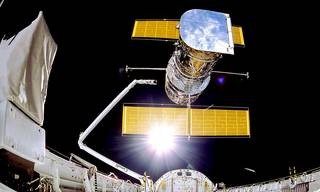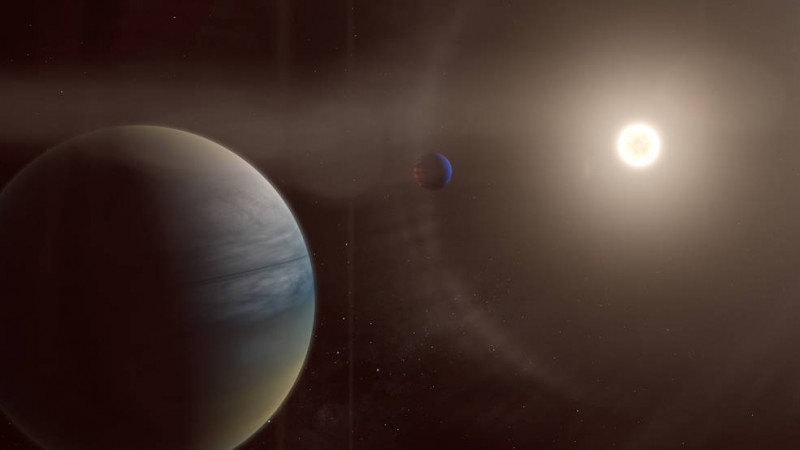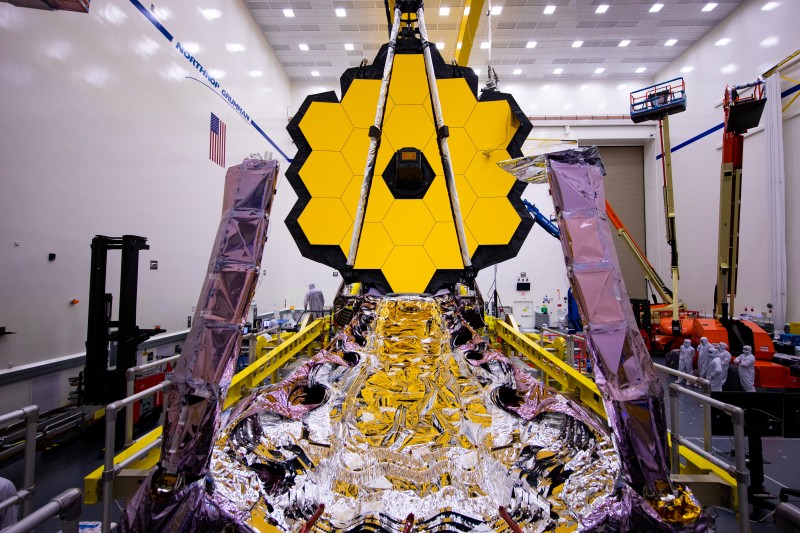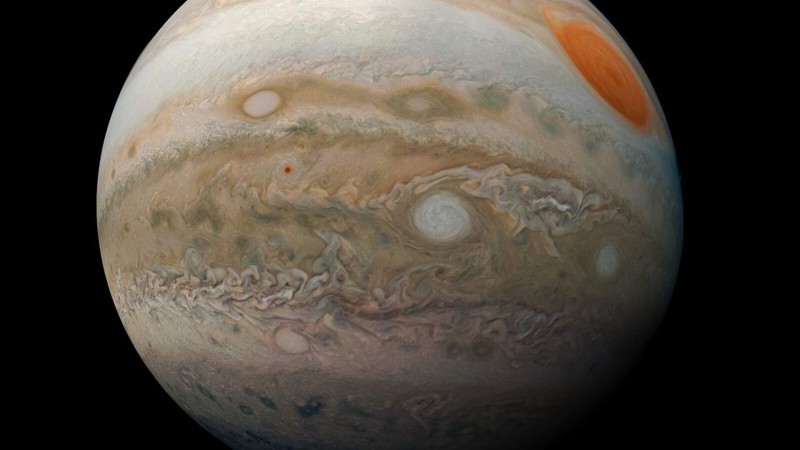News
Mystery object blotted out a giant star for 200 days
Friday, June 18th 2021 04:12 PM
Mystery object blotted out a giant star for 200 days
Stars may twinkle, but they don’t just vanish—so when a distant, giant star pulled a disappearing act for about 200 days, it took astronomers by surprise.
Now, roughly a decade later, astronomers have sifted through a variety of possible explanations—and they still have no idea what’s responsible for blotting out nearly all of the star’s light.
Described in a new study in the Monthly Notices of the Royal Astronomical Society, some of the theories still on the table rely on as-yet unobserved phenomena, such as a dark disk of material orbiting a nearby black hole, or undiscovered, dust-enshrouded companion stars. But over 17 years of observations, the star has only gone dark once, in 2012, making it more difficult for teams to nail down a plausible culprit.
It’s clear that whatever object eclipsed the distant star is huge—much bigger than the star itself. It also appeared to be completely...
Read More
Read More
Operations Underway to Restore Payload Computer on NASA's Hubble Space Telescope
Thursday, June 17th 2021 06:52 PM
Operations Underway to Restore Payload Computer on NASA's Hubble Space Telescope
NASA is working to resolve an issue with the payload computer on the Hubble Space Telescope. The computer halted on Sunday, June 13, shortly after 4 p.m. EDT. After analyzing the data, the Hubble operations team is investigating whether a degrading memory module led to the computer halt. The team is preparing to switch to one of several backup modules on Wednesday, June 16. The computer will then be allowed to run for approximately one day to verify that the problem has been solved. The team would then restart all science instruments and return the telescope to normal science operations.
The Hubble Space Telescope is deployed on April 25, 1990 from the space shuttle Discovery. Avoiding distortions of the atmosphere, Hubble has an unobstructed view peering to planets, stars and galaxies, some more than 13.4 billion light years away. (Credits: NASA/Smithsonian Institution/Lockheed Corporation)
The...
Read More
Read More
Citizen Scientists Discover Two Gaseous Planets around a Bright Sun-like Star
Monday, June 14th 2021 04:36 PM
Citizen Scientists Discover Two Gaseous Planets around a Bright Sun-like Star
At night, seven-year-old Miguel likes talking to his father Cesar Rubio about planets and stars. “I try to nurture that,” says Rubio, a machinist in Pomona, California, who makes parts for mining and power generation equipment.
In this artist’s rendering, two gaseous planets orbit the bright star HD 152843. These planets were discovered through the citizen science project Planet Hunters TESS, in collaboration with professional scientists.
Now, the boy can claim his father helped discover planets, too. Cesar Rubio is one of thousands of volunteers participating in Planet Hunters TESS, a NASA-funded citizen science project that looks for evidence of planets beyond our solar system, or exoplanets. Citizen science is a way for members of the public to collaborate with scientists. More than 29,000 people worldwide have joined the Planet Hunters TESS effort to help scientists find exopl...
Read More
Read More
NASA Statement on James Webb Space Telescope Launch Readiness
Friday, June 11th 2021 04:45 PM
NASA Statement on James Webb Space Telescope Launch Readiness
NASA’s James Webb Space Telescope, which will be the premier observatory of the next decade, remains on schedule for a launch readiness date no earlier than Oct. 31, 2021.
Webb will ship to the launch site in August with little to no schedule margin; launch processing will take two months. The observatory has completed all the post-environmental testing deployments, and it is in its final integration and folding stages. Final stow, closeout, and pack and ship are imminent. We are working closely with the European Space Agency (ESA) and Arianespace on establishing the launch date. We will launch approximately four months after the first launch of the Ariane 5 this year, which is scheduled for late July. Webb has no launch date constraints; hence, it can launch almost any day of the year.
Webb will study every phase in the history of our universe, including the first luminous glows after the creation of the co...
Read More
Read More
Strange FM signal discovered coming from one of Jupiter's moons
Thursday, June 10th 2021 04:00 PM
Strange FM signal discovered coming from one of Jupiter's moons
NASA recently extended the life of two of its planetary discovery missions, including the Juno mission to Jupiter. Now it's come to light Juno has discovered an FM signal emanating from one of the gas giant's moons, Ganymede.
The discovery is not an indication of extraterrestrial life, but it is fascinating nonetheless, given it's the first time it's been discovered coming from the celestial satellite.
"It’s not E.T.," Patrick Wiggins, one of NASA’s ambassadors to Utah, said in comments obtained by ABC 4. "It’s more of a natural function."
Natural color view of Ganymede from the Galileo spacecraft during its first encounter with the satellite. North is to the top of the picture and the sun illuminates the surface from the right. The dark areas are the older, more heavily cratered regions and the light areas are younger, tectonically deformed regions. (NASA/JPL)
The spacecraft, which launched...
Read More
Read More
Spacecraft buzzes Jupiter's mega moon, 1st close-up in years
Wednesday, June 9th 2021 06:47 PM
Spacecraft buzzes Jupiter's mega moon, 1st close-up in years
Juno zoomed past icy Ganymede, passing within 645 miles of planet surface
Fox News Flash top headlines for June 8
CAPE CANAVERAL, Fla. — NASA’s Juno spacecraft has provided the first close-ups of Jupiter’s largest moon in two decades.
Juno zoomed past icy Ganymede on Monday, passing within 645 miles (1,038 kilometers). The last time a spacecraft came that close was in 2000 when NASA’s Galileo spacecraft swept past our solar system’s biggest moon.
NASA released Juno’s first two pictures Tuesday, highlighting Ganymede’s craters and long, narrow features possibly related to tectonic faults. One shows the moon's far side, opposite the sun.
This June 7, 2021 image made available by NASA shows the Jovian moon Ganymede as the Juno spacecraft flies by. "This is the closest any spacecraft has come to this mammoth moon in a generation," said Juno's lead scientist, Scott...
Read More
Read More
NASA’s Juno to Get a Close Look at Jupiter’s Moon Ganymede
Friday, June 4th 2021 04:32 PM
NASA’s Juno to Get a Close Look at Jupiter’s Moon Ganymede
Left to right: The mosaic and geologic maps of Jupiter’s moon Ganymede were assembled incorporating the best available imagery from NASA’s Voyager 1 and 2 spacecraft and NASA’s Galileo spacecraft.
The first of the gas-giant orbiter’s back-to-back flybys will provide a close encounter with the massive moon after over 20 years.
On Monday, June 7, at 1:35 p.m. EDT (10:35 a.m. PDT), NASA’s Juno spacecraft will come within 645 miles (1,038 kilometers) of the surface of Jupiter’s largest moon, Ganymede. The flyby will be the closest a spacecraft has come to the solar system’s largest natural satellite since NASA’s Galileo spacecraft made its penultimate close approach back on May 20, 2000. Along with striking imagery, the solar-powered spacecraft’s flyby will yield insights into the moon’s composition, ionosphere, magnetosphere, and ice shell. Juno&rsq...
Read More
Read More
NASA will head to Venus for first time in roughly 30 years
Thursday, June 3rd 2021 04:12 PM
NASA will head to Venus for first time in roughly 30 years
Two spacecraft aim to solve deep mysteries about the nearby planet, including why it resembles a hellish, toxic version of Earth.
NASA had a surprise in store for planetary scientists today: During a “State of NASA” briefing, the agency announced that roiling, toxic Venus will be the target of the next two missions in its highly competitive Discovery program.
“These two sister missions, both aimed to understand how Venus became an inferno-like world capable of melting lead at the surface—they will offer the entire science community the chance to investigate a planet we haven’t been to in more than 30 years,” NASA Administrator Bill Nelson said during the briefing. “We hope these missions will help further our understanding of how Earth evolved and why it’s currently habitable, when other [rocky planets] in our solar system are not.”
One spacecraft, called DAVINCI+, wil...
Read More
Read More
Celestron’s StarSense Explorer
Wednesday, June 2nd 2021 04:44 PM
Celestron’s StarSense Explorer
Guided by your smartphone, these scopes are easy to use and on target every time.
The Celestron StarSense Explorer DX 130AZ is a 5.1-inch (130 mm) f/5 Newtonian reflector ideal for beginning observers. It comes complete with a preassembled mount and tripod, two eyepieces, and several other goodies.
Choosing a first telescope is a difficult task for a fledgling amateur astronomer. Frequently, newcomers pick telescopes with computerized go-to controls, only to discover after a lot of frustration — and expense — that the telescope is too complicated to use right out of the box. Or, they go with a simple telescope that requires finding objects manually using a finder scope. But in today’s light-polluted world, that can be a tall order — sometimes just seeing basic constellations is impossible.
Celestron has tackled head-on the challenge of choosing equipment as a beginning observer with their StarSense Explorer telesc...
Read More
Read More
NASA’s Curiosity Rover Captures Shining Clouds on Mars
Tuesday, June 1st 2021 04:53 PM
NASA’s Curiosity Rover Captures Shining Clouds on Mars
NASA’s Curiosity Mars rover captured these clouds just after sunset on March 19, 2021, the 3,063rd Martian day, or sol, of the rover’s mission. The image is made up of 21 individual images stitched together and color corrected so that the scene appears as it would to the human eye.
The science team is studying the clouds, which arrived earlier and formed higher than expected, to learn more about the Red Planet.
Cloudy days are rare in the thin, dry atmosphere of Mars. Clouds are typically found at the planet’s equator in the coldest time of year, when Mars is the farthest from the Sun in its oval-shaped orbit. But one full Martian year ago – two Earth years – scientists noticed clouds forming over NASA’s Curiosity rover earlier than expected.
This year, they were ready to start documenting these “early” clouds from the moment they first appeared in late January. What...
Read More
Read More









